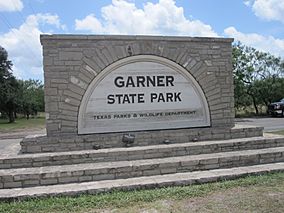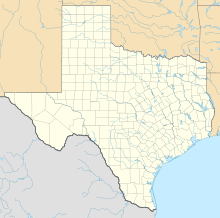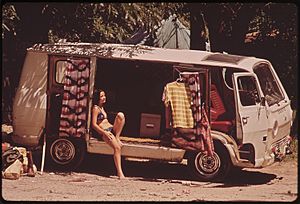Garner State Park facts for kids
Quick facts for kids Garner State Park |
|
|---|---|
 |
|
| Location | Uvalde County, Texas |
| Area | 1,420 acres (5.7 km2) |
| Established | 1941 |
| Governing body | Texas Parks and Wildlife Department |
Garner State Park is a very popular state park in Texas. It is found in Uvalde County, near the town of Concan, Texas. This park is famous for its beautiful Texas Hill Country scenery. It is the most visited state park in Texas for people who want to stay overnight. During busy times, the park often fills up by noon! Visitors love the fun activities on the Frio River and the dances held every night during spring and summer.
Park History
In the early 1930s, Garner State Park was created for two main reasons. First, it helped save a beautiful part of the Texas Hill Country for everyone to enjoy. Second, it gave jobs to men who were struggling during the Great Depression. The Great Depression was a time when many people could not find work.
The land for the park was bought between 1934 and 1936. In 1934, the Texas State Parks Board chose this spot for a new park. The Texas Legislature then provided money to build state parks. The Civilian Conservation Corps (CCC) did most of the early work. The CCC was a government program that gave jobs to young men. They built important structures like the large pavilion and a building for snacks and drinks.
The land was officially given to the State Parks Board in 1936. Garner State Park then opened its doors to the public in 1941. The park was named after John Nance Garner. He was a former Vice President of the United States who lived and worked as a lawyer in the Concan area. The park grew much larger in 1976 when an extra 790 acres (320 ha) were added.
Nature at the Park
Park Geology
The land around Garner State Park was formed millions of years ago during the Cretaceous period. This is when the Edwards Plateau was created. A large section of land was lifted about 2,000 feet along a curving fault line. Today, the park sits on the edge of this plateau. You can see tall flat-topped hills called mesas, steep limestone cliffs, deep canyons, and clear blue streams.
Park Plants (Flora)
The park has many different kinds of plants. This is because the canyons are angled in a way that helps cool and moisten the area with the wind.
Bald Cypress Trees: Life Cycle and Importance
The bald cypress trees grow along the Frio River. These amazing trees can reach up to 120 feet tall and live for 600 years! They get their name because their leaves fall off in the autumn and do not grow back until late spring. This makes them look "bald" for a long time.
Bald cypress trees are very helpful to the Frio River. They slow down floodwater and trap dirt and pollution. They also provide great places for wildlife to build nests, find food, and find shelter.
Texas Madrone Trees
The Arbutus xalapensis, also known as the Texas madrone, is a special and rare tree. It usually grows to be about 20 to 30 feet tall. The trunk of this tree has beautiful red inner bark that peels off in thin sheets of orange and brown. In the spring, white bell-shaped flowers bloom. These flowers then turn into red and orange berries.
Park Animals (Fauna)
Garner State Park is home to many different animals. You might see deer, squirrels, raccoons, turkeys, and even skunks! The park staff sometimes jokingly call the skunks "security." Two types of endangered birds also make their nests in this park.
Golden-cheeked Warbler: Nesting Habits
The golden-cheeked warbler is a small bird that only nests in Central Texas. They build their nests in woodlands that have both Ashe juniper and oak trees. They are usually found here from March to July. These birds eat insects and spiders from the trees. They even use spider webs to help build their nests! Sadly, these birds are endangered because they are losing the places where they like to nest.
Black-capped Vireo: Nesting Habits
The black-capped vireo is another very small bird that nests in Texas. They arrive in the spring, usually from April to July. They build their nests in low shrubs. These birds are also endangered. This is because their habitats are being destroyed by things like grazing animals, land clearing, and stopping natural fires.
Park Facilities
Campsites and Cabins
Because Garner State Park is so popular, you need to make a reservation ahead of time to visit. You can choose to stay in a tent or RV site, a screened shelter, or a cabin. The cabins have fireplaces, kitchen areas, and indoor bathrooms. If you choose a campsite or screened shelter, there are public restrooms and showers available for all park guests to use.
Garner Grill
The famous Garner Grill is open during the day. It is located next to the big pavilion. The food is always cooked fresh, but it might take a little while to get your order. Each season, they even have a new souvenir cup design that you can collect! Remember, the Grill is open every day during the summer. However, it is closed during the off-season, which is usually from October to February.
Gift Shop
The park's gift shop is a great place to buy souvenirs. You can find jewelry, boots, toys, and other cool items. They even have clothes with the park's name on them. If the gift shop is closed, you can also shop online. The online store is updated regularly.
Fun Activities
There are many fun things to do at Garner State Park! You can go hiking, learn about nature, have a picnic, go canoeing, or try fishing. During spring and summer, you can rent paddle boats and kayaks. You can also go bicycle riding or play miniature golf.
Day Use Visitors
Garner State Park is the most popular park in the Texas State Parks system. Because so many people want to visit, it is a good idea to make a "Day Use" reservation. This is especially true during the quieter months from October to February. During the very busy months from March to September, you *must* have a Day Use reservation before you come to the park. This makes sure you can get in!
Ranger Programs
If you want to learn more about the park, you can sign up for ranger programs. Park rangers teach visitors about the park's nature, history, and traditions. Campers can join geology programs or go on guided nature hikes.
Volunteer Opportunities
You can also help out at the park as a volunteer! Volunteers help keep the park clean by taking care of trails. They also help renew animal habitats, become park hosts, or lead educational programs for visitors.
Images for kids
-
Bald cypress trees along the Frio River in Garner State Park.
- Garner State Park from the Handbook of Texas Online









